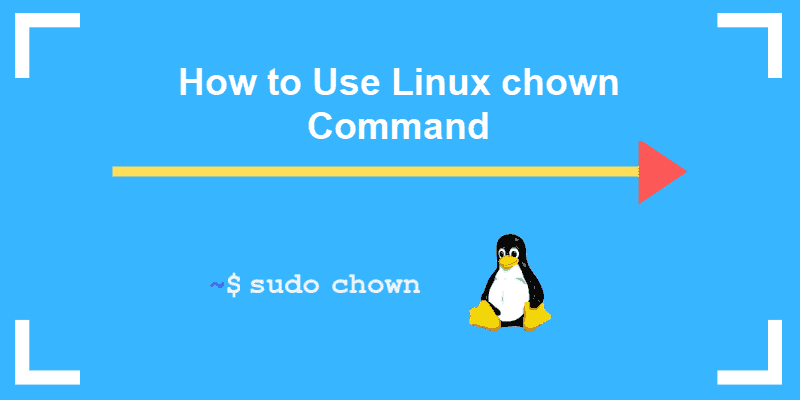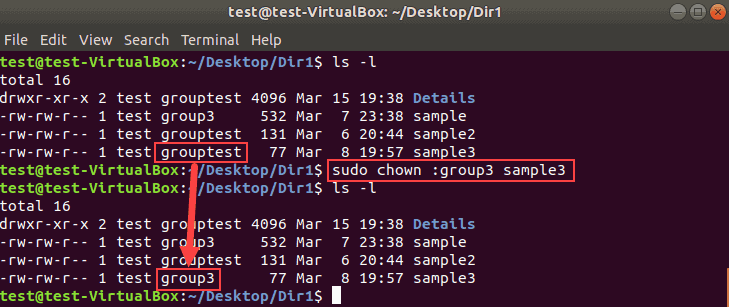Introduction
The chown command changes user ownership of a file, directory, or link in Linux. Every file is associated with an owning user or group. It is critical to configure file and folder permissions properly.
In this tutorial, learn how to use the Linux chown command with examples provided.

Prerequisites
- Linux or UNIX-like system
- Access to a terminal/command line
- A user with sudo privileges to change the ownership. Remember to run the commands with sudo to execute them properly.
Linux Chown Command Syntax
The basic chown command syntax consists of a few segments. The help file shows the following format:
chown [OPTIONS] USER[:GROUP] FILE(s)- [OPTIONS] – the command can be used with or without additional options.
- [USER] – the username or the numeric user ID of the new owner of a file.
- [:] – use the colon when changing a group of a file.
- [GROUP] – changing the group ownership of a file is optional.
- FILE – the target file.
Superuser permissions are necessary to execute the chown command.
In this guide, we tested the command examples with the chown version 8.28 in Ubuntu 18.04.2 LTS.
To check the chown version on your machine, enter:
chown --versionThe output will look similar to this:

How to Check Ownership of a File in Linux
First, you need to know the original file owner or group before making ownership changes using the chown command.
To check the group or ownership of Linux files and directories in the current location, run the following command:
ls -lAn example output of the ls command looks like this:

How to Change the Owner of a File
Changing the owner of a file with chown requires you to specify the new owner and the file. The format of the command is:
chown NewUser FILEThe following command changes the ownership of a file sample from root to the user test:
chown test sample
Use the same format to change the ownership for both files and directories.
Change the Owner of a File With UID
Instead of a username, you can specify a user ID to change the ownership of a file.
For example:
chown 1002 sample2Make sure there is no user with the same name as the numeric UID. If there is, the chown command gives priority to the username, not the UID.
Note: To check a user’s ID, run id -u USERNAME from the terminal.
Change Ownership of Multiple Linux Files
List the target file names after the new user to change the ownership for multiple files. Use single spaces between the file names.
In the following example, root will be the new owner of files sample2 and sample3.
chown root sample2 sample3Combine file names and directory names to change their ownership with one command. For example:
chown root sample3 Dir1Do not forget that the commands are case sensitive.
How to Change the Group of a File
With chown, you can change a group for a file or directory without changing the owning user. The result is the same as using the chgrp command.
Run the chown command using the colon and a group name:
chown :NewGroup FILEThe following example changes the group of the file sample3 from grouptest to group3.
chown :group3 sample3
List multiple names of files or directories to make bulk changes.
Change the Group of a File Using GID
Similar to UID, use a group ID (GID) instead of a group name to change the group of a file.
For example:
chown :1003 sampleChange Owner and the Group
To assign a new owner of a file and change its group at the same time, run the chown command in this format:
chown NewUser:NewGroup FILETherefore, to set linuxuser as the new owner and group2 as the new group of the file sample2:
chown linuxuser:group3 sample3Remember that there are no spaces before or after the colon.
Change Group to a Users Login Group
The chown command assigns the owner’s login group to the file when no group is specified.
To do so, define a new user followed by a colon, space, and the target file:
chown NewUser: FILEThe following example changes the group ownership to the login group of linuxuser:
chown linuxuser: sample3Transfer Ownership and Group Settings from One File to Another
Rather than changing the ownership to a specific user, you can use the owner and a group of a reference file.
Add the --reference option to the chown command to copy the settings from one file to another:
chown --reference=ReferenceFILE FILERemember to type in the names of the files correctly to avoid the error message:

Check Owner and Group Before Making Changes
The chown command --from option lets you verify the current owner and group and then apply changes.
The chown syntax for checking both the user and group looks like this:
chown --from=CurrentUser:CurrentGroup NewUser:NewGroup FILEThe example below shows we first verified the ownership and the group of the file sample3:
chown --from=root:group2 linuxuser:group3 sample3Then chown changed the owner to linuxuser and the group to group3.
Check Owner Only
The option --from can be used to validate only the current user of a file.
chown --from=CurrentUser NewUser FILEFor example:
chown --from=root linuxuser sample3Check Group Only
Similar to the previous section, you can validate only the group of a file using the option --from.
chown --from=:CurrentGroup :NewGroup FILEHere is an example where we verified the current group before changing it:
chown --from=:group3 :group4 FILERemember to use the colon for both group names to avoid error messages.
How to Recursively Change File Ownership
The chown command allows changing the ownership of all files and subdirectories within a specified directory. Add the -R option to the command to do so:
chown -R NewUser:NewGroup DirNameOrPathIn the following example, we will recursively change the owner and the group for all files and directories in Dir1.
chown -R linuxuser:group3 Dir1Chown Command and Symbolic Links
To change the owner of a symbolic link, use the -h option. Otherwise, the ownership of the linked file will be changed.
The following image shows how symbolic links behave when -h is omitted.

The owner and group of the symbolic link remain intact. Instead, the owner and the group of the file textfile changed.
To push the changes to the link, run the chown command with the -h flag:
chown -h NewUser:NewGroup SymbolicLinkIn the following example, we changed the owner and group of a symbolic link.

Display Chown Command Process Details
By default, the terminal does not display the chown process information. To see what happens under the hood, use one of the two command line flags:
- The option –v produces the process details even when the ownership stays the same.
- The option –c displays the output information only when an owner or group of the target file changes.
For example, if we specify the current owner as a new owner of the file:
chown -v linuxuser sample2The terminal produces the following output:

Switch from -v to -c and there will be no messages in this case. This happens because there are no owner or group changes.
The information is particularly useful with the recursive chown command:

In this example, the output lists all objects affected after running the command.
Suppress Chown Command Errors
To avoid seeing potential error messages when running the chown command, use the -f option:
chown -f NewUser FILEThe example below shows the error message for a non-existent file or directory:

Adding the -f flag suppresses most error messages. However, if you specify an invalid username, the error message appears:

Conclusion
Now you know how to use chown command in Linux to change a file’s user and/or group ownership.
Take extra caution when changing the group or ownership of a file or directories.